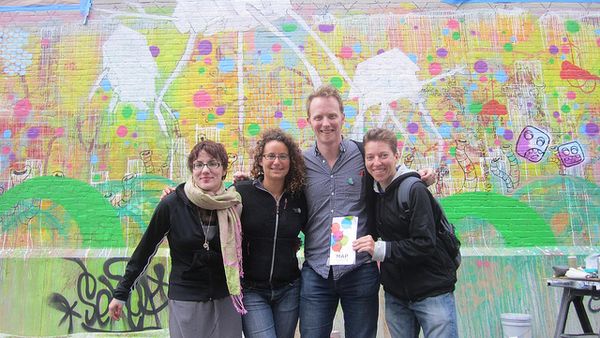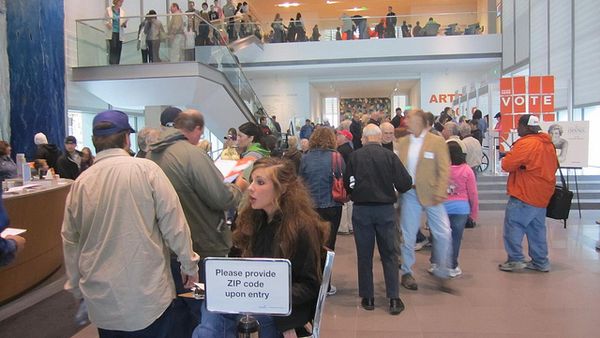Learning from ArtPrize
As we continue to move forward throughout the summer, it seems fitting to talk about the inspiration behind GO. I’ve already mentioned that the Brooklyn Arts Council Registry had a big hand in helping us visualize how many artists were working in Brooklyn, but it was my first visit to ArtPrize that really galvanized my thoughts about what a next-generation community-curated process could be. ArtPrize is a publicly held art competition held every year in Grand Rapids, Michigan. The concept is simple: any artist in the world can bring one work to Grand Rapids and display it in a local venue. Over a two-week period, the community looks at the work and votes for what they like; the winners get a monetary prize.
When you visit ArtPrize, you’ll find almost every place opens their doors to show art. Venues are what you would expect—bookstores, cafes, restaurants, galleries, exhibition centers—but there are also surprises—the dog shelter, a hairdressing salon, the Salvation Army, and local churches all serve as ArtPrize venues. As a visitor, it feels as if the entire city opens its doors and this openness fosters an incredible dialogue. Voting is just one part of the experience and not something every participant does, but art is everywhere and people talk about it. Simply put, I had never seen more quality engagement taking place at any arts-related event, and it left me wondering what would happen if we did something similar in Brooklyn.

I visited ArtPrize in 2010 with a group of friends and while we did not consider ourselves to be "art people," we were thoroughly engaged by ArtPrize. The mural behind us is by Grand Rapids artist Erwin Erkfitz, who we found painting on the spot.
After my first visit to ArtPrize in 2010, Sharon and I started discussing what it would mean for the Brooklyn Museum to host a project like this. Knowing how Brooklyn and Grand Rapids differ greatly, we could easily see what worked in one location might not be easily replicated in another, but we also felt that the participation model would need to adjusted to suit the Museum’s goals. How could we create a structure that would be less about voting and more about curation and collaboration? If we managed that task, how could we appropriately scale the project to span an area equivalent to the fourth largest city in the United States? The following year, the two of us travelled to ArtPrize together and we used the trip to really think through some of the participation models and what we thought might be the right fit for Brooklyn; we were also able to talk to ArtPrize staff about these ideas and were struck by how incredibly open they were to our finding inspiration in their project and making modifications that fit Brooklyn.
One similarity you’ll find between ArtPrize and GO is a reliance on people to participate in person, not online. Digital tools may be used to help plan your visit and capture your interest in an artist’s work, but the primary focus is seeing art and being physically present to do so. At ArtPrize, participants have to confirm their registration in-person in order to vote. During GO, participants will go to studios and record their visit using the unique number that we assign each artist and they’ll only be able to nominate artists from the list of studios they visited. Both models encourage visitors to weigh-in on works of art after they’ve seen them in person.

At ArtPrize, participants can pre-register online, but they must show up with ID to confirm their registration on site in Grand Rapids.
The participation model also differs from that of ArtPrize where there’s a straight up/down vote into a top ten, then a re-vote within that subset to determine the top artists. For GO, we ask participants to “check-in” at studios instead of voting right there on the spot. If you want to nominate artists for the group show, you’ll need to “check-in” to at least five studios to be eligible to nominate three from the list of places you visited. In this, we wanted to shift the engagement model to encourage participants to think about making choices, much like our curators have to do on a daily basis. By removing the “vote” from the event itself, we hope that participants will experience the weekend and let their thoughts marinate a bit before finalizing their nominations.
The staff at ArtPrize have been incredibly helpful throughout the process of conceptualizing GO. They’ve gone so far as to discuss what worked for them and what didn’t. We’ve talked extensively about their data metrics and we’ve been able to take those lessons and insights and adapt them for our own participation model. As we move past our open studio weekend on September 8 and 9, we’ll be sharing our lessons learned back to ArtPrize, so they, in turn, can learn from our experiences.

Shelley Bernstein is the former Vice Director of Digital Engagement & Technology at the Brooklyn Museum where she spearheaded digital projects with public participation at their center. In the most recent example—ASK Brooklyn Museum—visitors ask questions using their mobile devices and experts answer in real time. She organized three award-winning projects—Click! A Crowd-Curated Exhibition, Split Second: Indian Paintings, GO: a community-curated open studio project—which enabled the public to participate in the exhibition process.
Shelley was named one of the 40 Under 40 in Crain's New York Business and her work on the Museum's digital strategy has been featured in the New York Times.
In 2016, Shelley joined the staff at the Barnes Foundation as the Deputy Director of Digital Initiatives and Chief Experience Officer.
